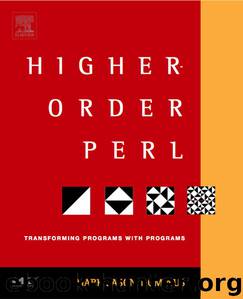Higher-Order Perl : Transforming Programs with Programs by Mark-Jason Dominus

Author:Mark-Jason Dominus
Language: eng
Format: epub
Tags: Perl, Programming
ISBN: 1-55860-701-3
Publisher: Morgan Kaufmann
Published: 2005-08-14T16:00:00+00:00
(s|stail).(t | ttail) = s.t | s.ttail |stail.t|stail.ttail
The first of these contains only one string. The middle two are simple transformations of the tails of S and T. The last one is a recursive call to the concat() function itself. So the code is simple:
sub concat { my ($S, $T) = @_; return unless $S && $T; my ($s, $t) = (head($S), head($T)); node("$s$t", promise { union( postcat(tail($S), $t), precat(tail($T), $s), concat(tail($S), tail($T)), ) }); }
precat() and postcat() are simple utility functions that concatenate a string to the beginning or end of every element of a stream:
sub precat { my ($s, $c) = @_; transform {"$c$_[0]"} $s; } sub postcat { my ($s, $c) = @_; transform {"$_[0]$c"} $s; }
An example:
# I’m /ˆ(a|b)(c|d)$/ my $z = concat( union(literal("a"), literal("b")), union(literal("c"), literal("d")), ); show($z); acbc adbd
The behavior of concat() is illustrated in Figure 6.3.
Download
This site does not store any files on its server. We only index and link to content provided by other sites. Please contact the content providers to delete copyright contents if any and email us, we'll remove relevant links or contents immediately.
Deep Learning with Python by François Chollet(12868)
Hello! Python by Anthony Briggs(10120)
The Mikado Method by Ola Ellnestam Daniel Brolund(10011)
OCA Java SE 8 Programmer I Certification Guide by Mala Gupta(9980)
Dependency Injection in .NET by Mark Seemann(9516)
Algorithms of the Intelligent Web by Haralambos Marmanis;Dmitry Babenko(8522)
Grails in Action by Glen Smith Peter Ledbrook(7881)
Test-Driven iOS Development with Swift 4 by Dominik Hauser(7853)
The Well-Grounded Java Developer by Benjamin J. Evans Martijn Verburg(7770)
Becoming a Dynamics 365 Finance and Supply Chain Solution Architect by Brent Dawson(7721)
Microservices with Go by Alexander Shuiskov(7474)
Practical Design Patterns for Java Developers by Miroslav Wengner(7398)
Test Automation Engineering Handbook by Manikandan Sambamurthy(7339)
Angular Projects - Third Edition by Aristeidis Bampakos(6767)
Secrets of the JavaScript Ninja by John Resig Bear Bibeault(6635)
The Art of Crafting User Stories by The Art of Crafting User Stories(6254)
NetSuite for Consultants - Second Edition by Peter Ries(6200)
Demystifying Cryptography with OpenSSL 3.0 by Alexei Khlebnikov(6014)
Kotlin in Action by Dmitry Jemerov(5297)
